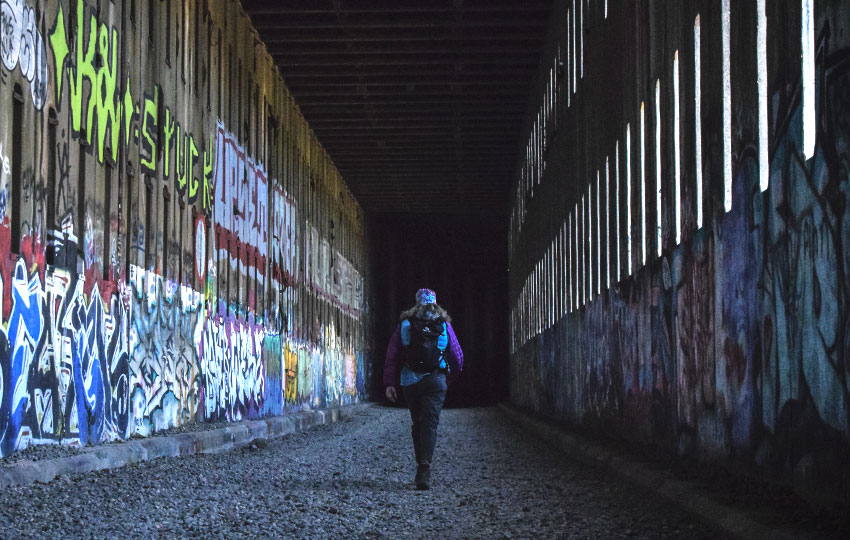
The railroad tunnels on Donner Pass provide, unquestionably, one of the most unique hiking experiences at Lake Tahoe. The Donner Pass train tunnels are fun for the whole family, particularly younger kids who find playing in the dark thrilling. But with that darkness comes the inherent risk of tripping and falling. So, bring with you a flashlight or headlamp to assist you on your journey. That said, the tunnel system on Donner Pass is a series of disconnected tunnels.
Also note that some of the tunnels feature various openings that allow light to filter inside the tunnel. So, you won’t be in total darkness during the entire hike (assuming you hike during the day!).
Support Tahoe Trail Guide with a financial contribution via PayPal (single contribution) or Patreon (reoccurring contributions). Your support of Tahoe Trail Guide is very much appreciated!

Hiking the Donner Pass train tunnels in the summer or fall months is ideal. During these months you’re less likely to encounter snow, ice, or standing water (from the previous winter) within the tunnels.
Lastly, the historic train tunnels form a makeshift art gallery for many graffiti artists. Regardless of your thoughts about graffiti, at this point in history the graffiti has become a mainstay. And, in fact, many people visit the tunnels specifically to see the graffiti.
Scroll to the bottom of the page for a brief historical overview of the Donner Pass tunnels and the graffiti that fills the tunnels.
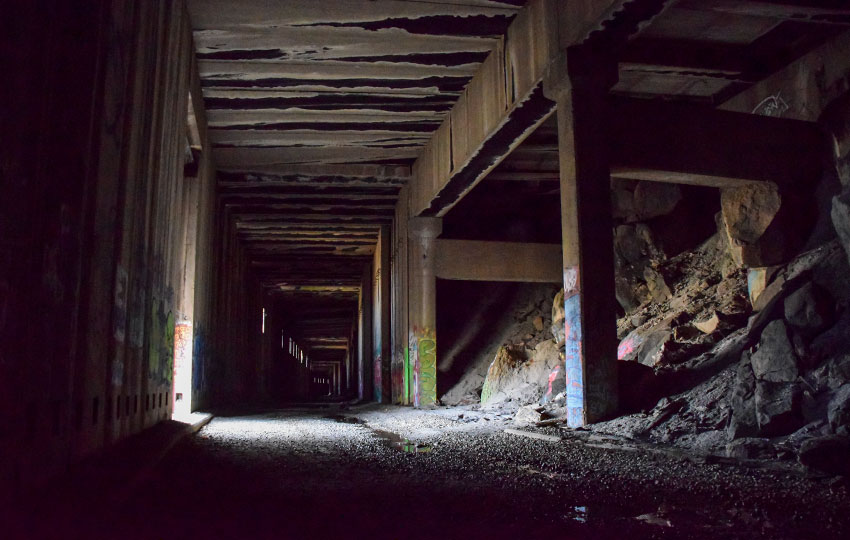
Donner Pass Tunnels Trail Data (approximations):
- Location: North Tahoe – Truckee – Donner Pass
- Category of Hike: Short Hike, Day Hike
- Hike Time: 2-3 hours
- Total Mileage: 5 miles (out-and-back)
- Trailhead Elevation: 7,000 feet
- Highest Point: 7,000 feet (trailhead)
- Total Elevation Gain: 250 feet
- Trail Condition: Hard-packed sand and rocky terrain
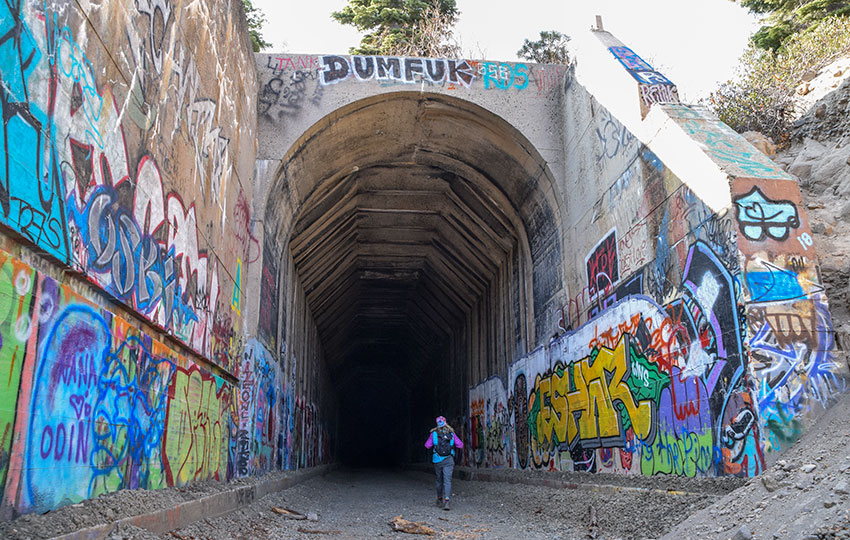
Considerations for Hiking Donner Pass Tunnels:
- There aren’t any artificial light sources in the Truckee Tunnels, so hiking through them can be disorienting. Bring a flashlight or headlamp if walking in the darkness is challenging for you.
- Be considerate of others and keep your use of a flashlight or head lamp to a minimum. Let your eyes adjust to the darkness – you’ll be surprised at just how good you can see in the dark.
- Be mindful of your steps – there are numerous tripping hazards such as rocks, natural debris, and slight variations in terrain.
- Depending on the previous winter’s snowpack, there can be standing pools of water or ice that can make for slippery terrain late into the summer.
- Be considerate of others in the tunnels by keeping your conversations to a low volume. The tunnels will amplify everything you say and, honestly, people don’t want to hear your conversations.
- Adhere to the Leave No Trace Seven Principles when hiking through the Donner Pass train tunnels
- There are few trail signs and markers on public lands in the Tahoe region. So, unless there are tracks to follow, the correct route may be difficult to identify – when in doubt, turn back.
- Be prepared for inclement weather and carry plenty of warm clothes, food, and water.
- Leave an itinerary of your plans with someone who’ll call emergency services if you don’t return by your prescribed time.
- Dogs are allowed, but keep them on leash and pick up after them. That last bit is critical because no one will be able to see dog poo before they step in it in a dark tunnel.

Parking for the Donner Pass Tunnels:
Choose between two parking areas for hiking the Donner Pass Train Tunnels.
1) Entrance to Tunnel #6. I prefer to start at the west entrance of Tunnel #6 since it’s as much of a beginning as you’re going to get from a hike. And, it ensures that you’ll hike through Tunnel #6, which is quite unique (see a brief description of Tunnel #6 below).
- Drive up Donner Pass Road (aka Old Highway 40) from Donner Lake.
- Drive just west of Ski Ranch Lane and Sugar Bowl Road and then pull into the dirt lot on the south side of Donner Pass Road.
There are no official signs to the train tunnels, but there’s a small dirt lot a few hundred meters from Donner Pass Road (at the beginning of Tunnel # 6.) The spot should be obvious since you’ll be able to see the tunnel (i.e. gaping hole) directly beneath Sugar Bowl Road.
Park in the lot and begin your hike through the Donner Pass Tunnels!
***Please note that this dirt parking area on the west side of Tunnel #6 is technically located on private property. The use of this parking area is either available due to a public easement or simply a laissez faire attitude by the property owners. I’ve asked friends who are members of the Donner Summit Historical Society, and have been told that they’ve reached out to the owners various times over the years to confirm whether or not they could use the lot (parking for their guided hikes). However, they’ve never received any response.
Park at your own risk in this dirt lot, but know that I’ve never heard of anyone being ticketed while parking there.
Here’s a map to help you find the dirt parking lot at the entrance of Tunnel #6.
2) Down the hill from Tunnel #6 on Donner Pass Road near the China Wall Marker. Park just off of Donner Pass Road at the dirt pullout near the China Wall Marker. This parking location is the most obvious to people who don’t live in the area. However, it does require a short hike up from the parking area which includes a little bit of scrambling up rocks. Although it’s not a difficult climb (to me), I would be hesitant to recommend this section for elderly people.
- Drive up Donner Pass Road (aka Old Highway 40) from Donner Lake.
- Park into the dirt pullout on the south side of Donner Pass Road at the China Wall Marker. This parking area is located just down the hill from the Donner Summit Bridge.
Please note that this parking area has limited space in which to park, so arrive early in the day for your hike. And, again, remember that you’ll have a short hike uphill to the train tunnels. Once you reach the train tunnel route, you’ll be in-between Tunnel #6 (to the west) and Tunnel #7 (to the east). Be sure to explore Tunnel #6 even though you’ll have to backtrack out of it.
Here’s a map to help you find the pullout along Donner Pass Road near the China Wall Marker.
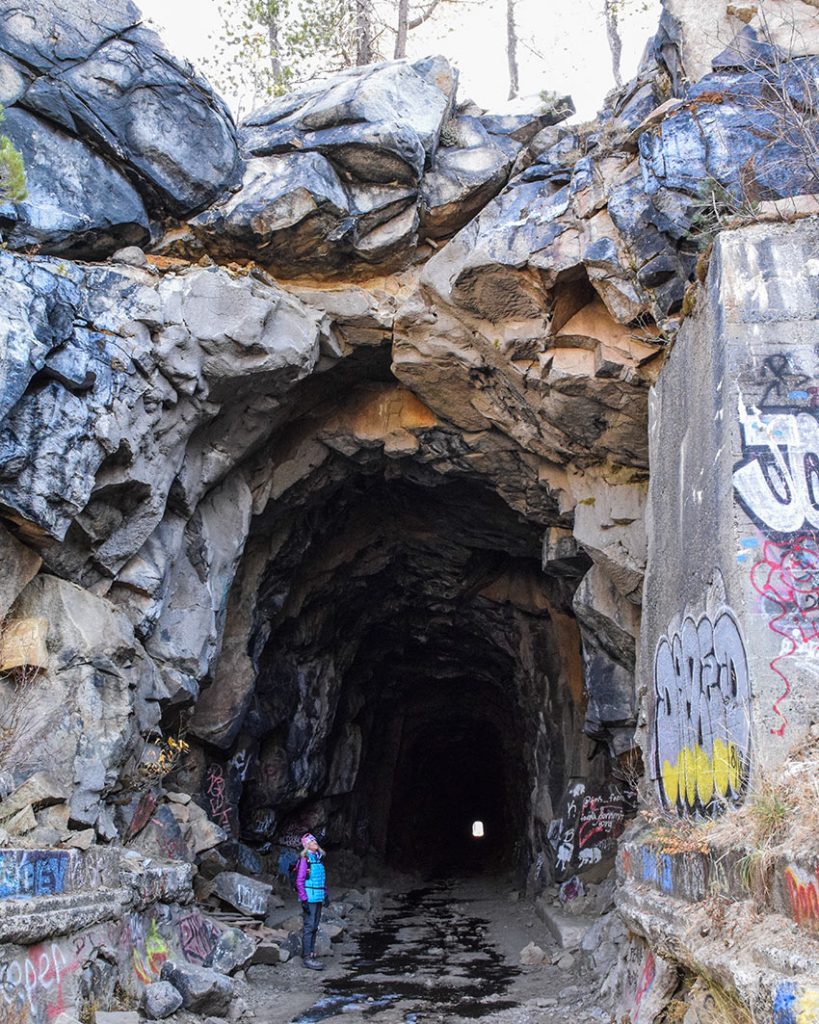
Donner Pass Tunnels Hiking Trail Directions:
There are numerous tunnels at Donner Pass. However, I recommend that you begin your hike of the Truckee Tunnels through Tunnel #6 regardless of where you park.
Tunnel #6 is the most unique and the longest (1,660 feet) of all the historic tunnels. The reason Tunnel #6 is interesting is because, at first, the Chinese only made about two feet per day of progress as they drilled from the west. Another team began to drill from the east. But this second team also had a difficult time drilling through the granite, so two more teams drilled from the top. In the end, the four teams reached within six inches of each other. And, it took over a year and a half to complete.
Most people generally begin at Tunnel #6 and just hike through the first few tunnels since the tunnels are disconnected and spread out.
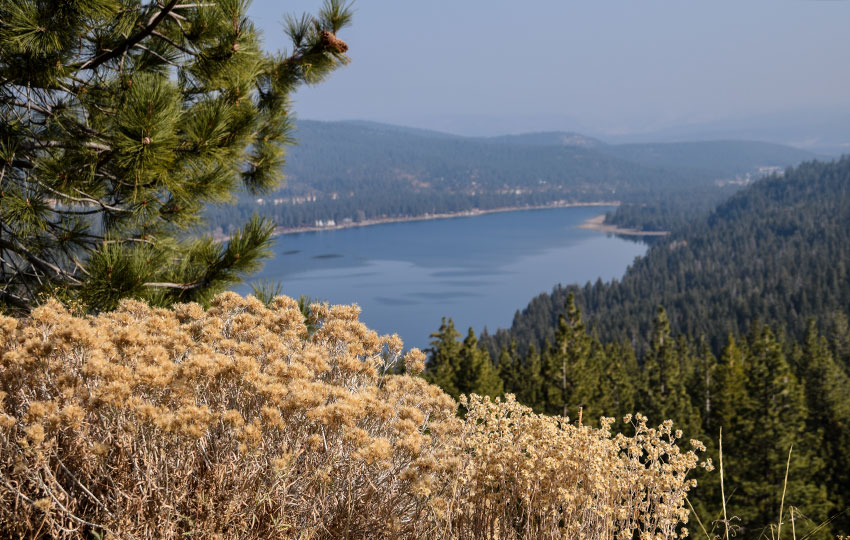
If you’re taking your time to look at the graffiti on the walls and being mindful of your steps, just hiking through those first few tunnels can take some time. Keep in mind that you naturally walk slower in the dark.
But if you have the time, I recommend hiking the full two miles of historic tunnels.
Once you get past the first couple of tunnels you’ll see very few people. And, at the end of the two miles, there’s usually a longer mural section of graffiti in which to admire. See the photo gallery below for a relatively extensive collection of graffiti art at the very end of the historic tunnels. That specific section is often sunlit and provides easy viewing.
The historic train tunnels are disconnected, so there are multiple open-air sections between them. And, each tunnel is of a different length.
During those breaks in the tunnels are where you’ll find a number of extended views. The most prominent views are of Donner Lake.
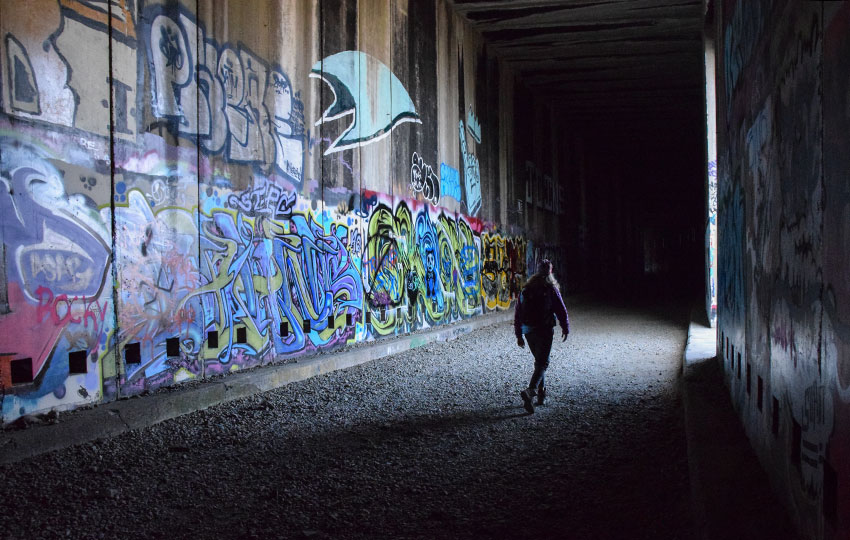
Look across the region and imagine being an emigrant in the late 1840s and into the 1850s. Then, imagine traveling across the pass before there was a railroad. To negotiate the granite pass with your family and all of your belongings in ox-drawn wagon(s), you would’ve had to be creative and ambitious.
There are a couple of different routes from which to choose, but none were easy. In fact, some of the routes emigrants took to overcome Donner Pass required them to completely disassemble their wagons and haul everything up the mountain piecemeal.
Or, imagine working on the tunnels year-round like the roughly 12,000 Chinese emigrants did in the mid to late-1860s.
Lastly, I like to hike just beyond the last historic tunnel as indicated on the map. At 2.5 miles, you’re out of the tunnels and at a good place to turn around.
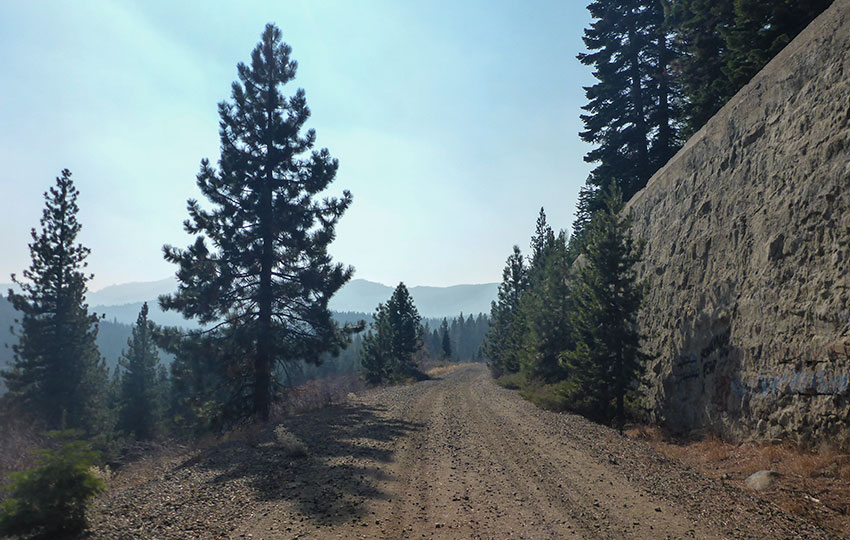
Brief History of the Historic Donner Pass Train Tunnels
Many people call Donner Pass the most historic square mile, meter, or foot (whichever you prefer!) in California. Some people consider it to be the most historical location in all the Western United States. No matter how you look at it, historically, Donner Pass has been the most traveled pass through the Sierra Nevada.
Donner Pass claims many “firsts,” to include:
- the first emigrants by wagon to California
- first transcontinental railroad
- the first transcontinental highway
- first transcontinental telephone line.
- Donner Pass is even the location of the first transcontinental air route (albeit in the skies directly above the pass).
And then there’s the fact that indigenous people have used the pass for thousands of years, long before any of the aforementioned “firsts.”
With regard to the hike through the “Truckee tunnels,” Donner Pass was essentially the crux of the transcontinental railroad. Theodore Judah, the architect of the railroad, proposed a tunnel system to address the threat of avalanches and snow blockages. So, the tunnels (aka snow sheds) acted as a physical barrier to keep snow from accumulating on the tracks.
But the tunnels wouldn’t build themselves.
By the end of the Gold Rush, thousands of Chinese immigrants were out of work. But, they were experienced miners. This was because they just came from working in the western gold and silver mines of the 1850s. This made them ideal candidates for working on the railroad. So, they signed on to build the tunnels and lay the railroad, particularly along Donner Pass. CA State Parks estimates that upwards of 12,000 (or possibly even a few thousand more) Chinese men worked on the railroad from 1863-1869.
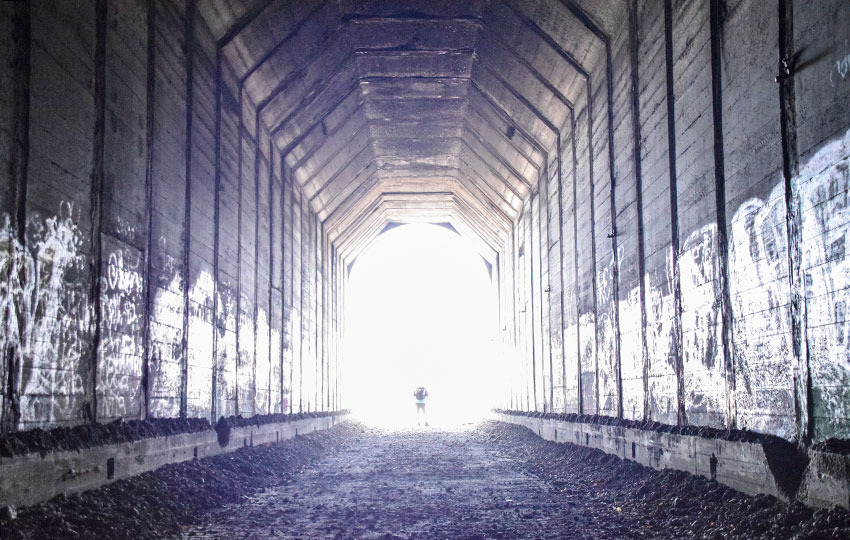
The story of the Chinese railroad workers is one of hope, despair, acceptance, and discrimination. It’s an amazing story that should be told on its own, not just as the bland footnote that I present here. But, I didn’t want to turn this article about actually hiking through the tunnels into a full-blown history lesson. Therefore, I’m simply mentioning this part of history since the whole reason for hiking the Donner Pass tunnels is the actual tunnels.
And, I believe that it’s important to understand a little about their history because those tunnels were built by a large force of underpaid and underappreciated Chinese immigrants.
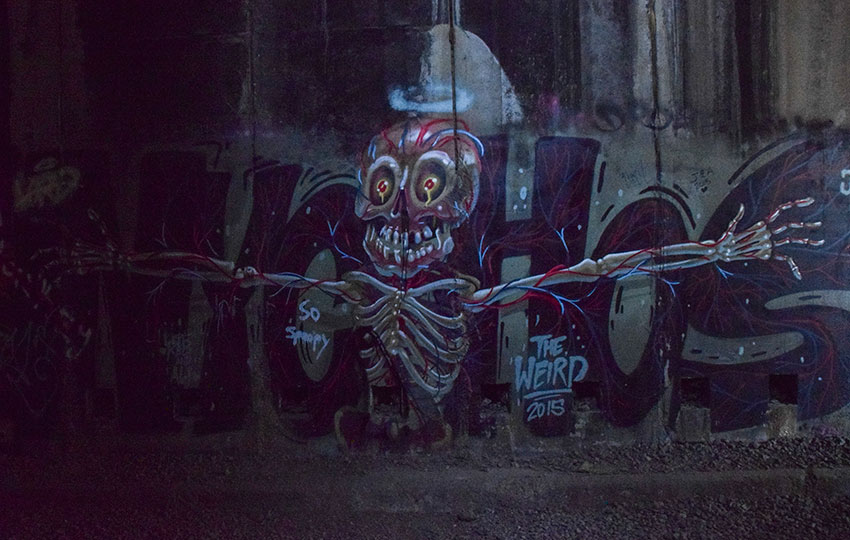
Thoughts about Graffiti at the Donner Pass Train Tunnels
It’s unavoidable that you’re going to see graffiti in the tunnels at this point. In fact, for many people the graffiti is the main attraction or highlight of the hike.
I’ve always had mixed feelings about graffiti art.
I loathe “tagging” that’s common to gangs to mark their territory. Mostly, I find graffiti to be a blight on the landscape, whether it be urban or otherwise. I don’t even like seeing painted rocks (with phrases like “love” and “peace”) placed in the forest. As far as I’m concerned, it’s all just litter because nature doesn’t need any help from humans to make it look more beautiful.
On the other hand, the thought-provoking works of Banksy is legendary.
All of that said, the tunnel art isn’t going anywhere. Periodically volunteers paint the walls, but graffiti artists always come back to add new work. So, don’t expect to see the graffiti that I’ve included in this article.
I’ve grown to appreciate the tunnel art at the Donner Pass Tunnels because some of it as actually nice to look at and the location is reminiscent of an art museum. I’m also grateful that most of the graffiti is contained within the tunnels and that the tunnels are dark, after all.
Do you have other insight, feedback, or trail updates about hiking the historic Donner Pass train tunnels?
If so, please post it in the comment section below for the benefit of everybody 🙂
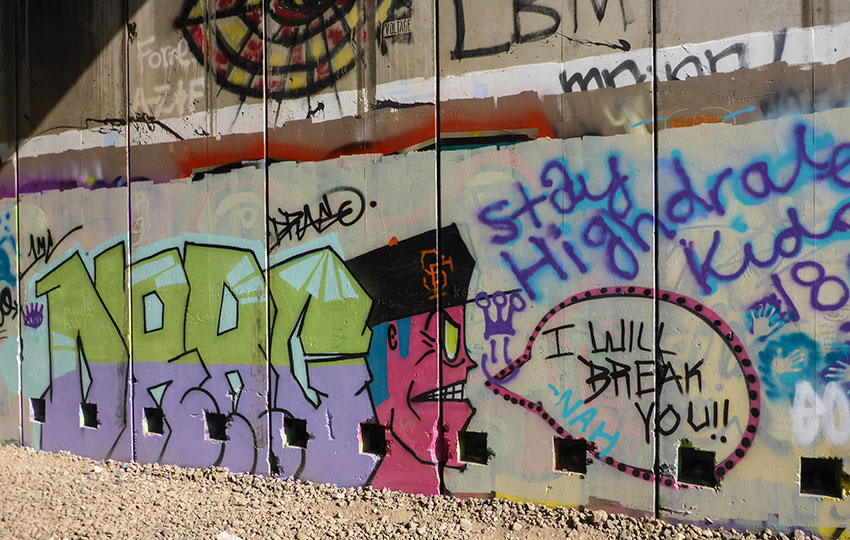
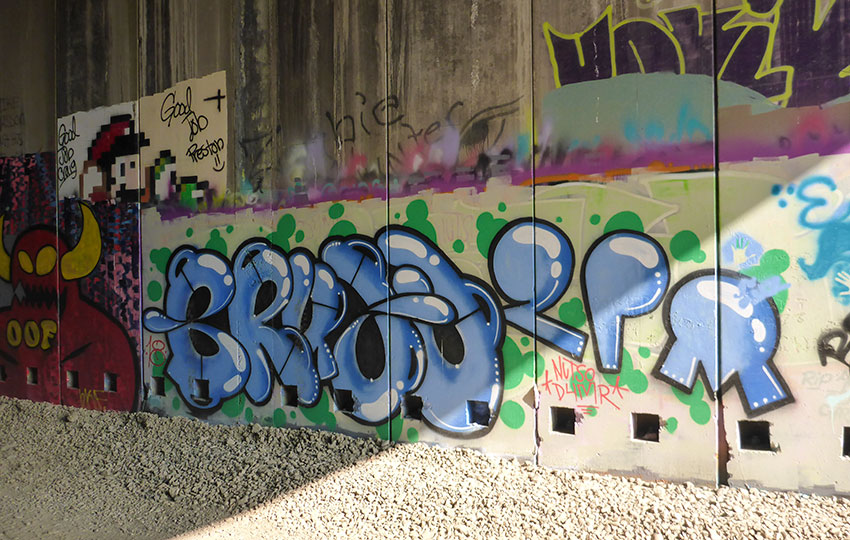
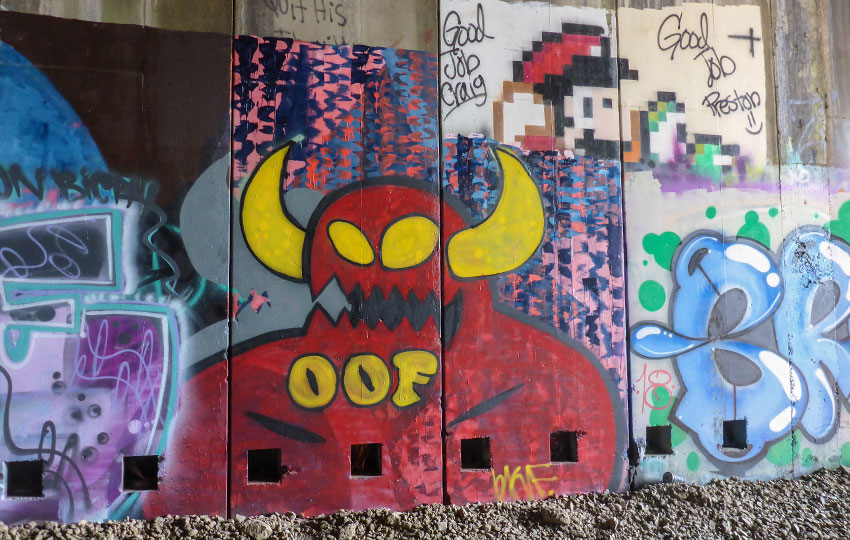
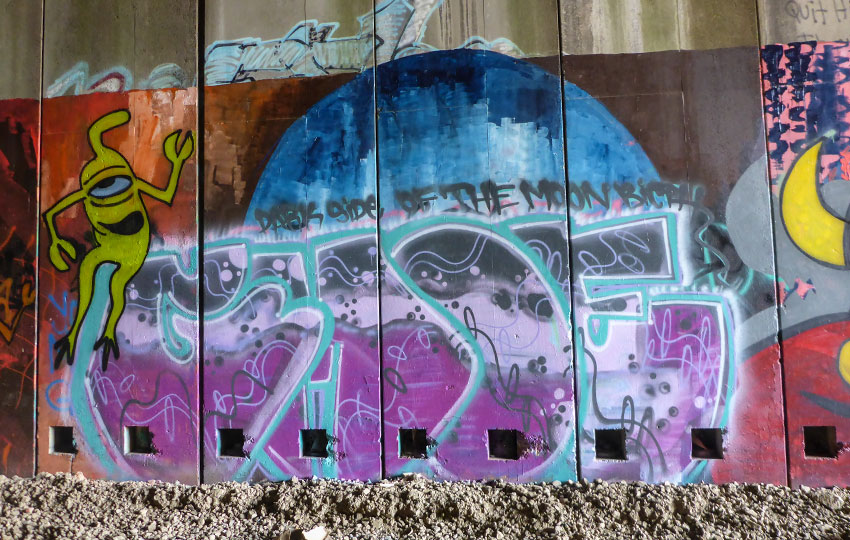
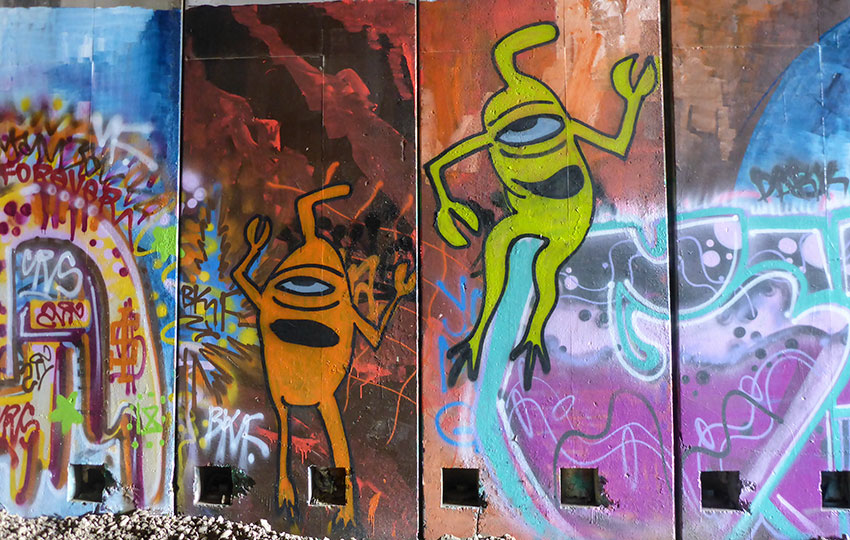
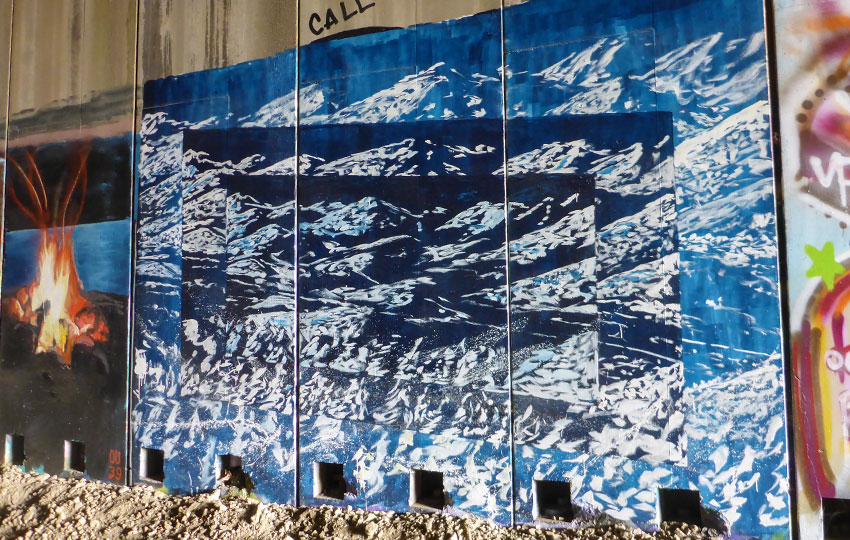
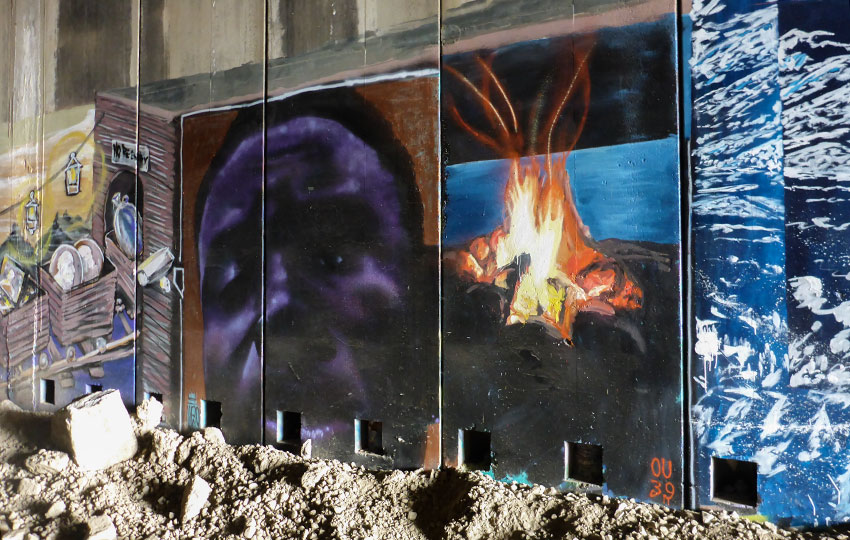
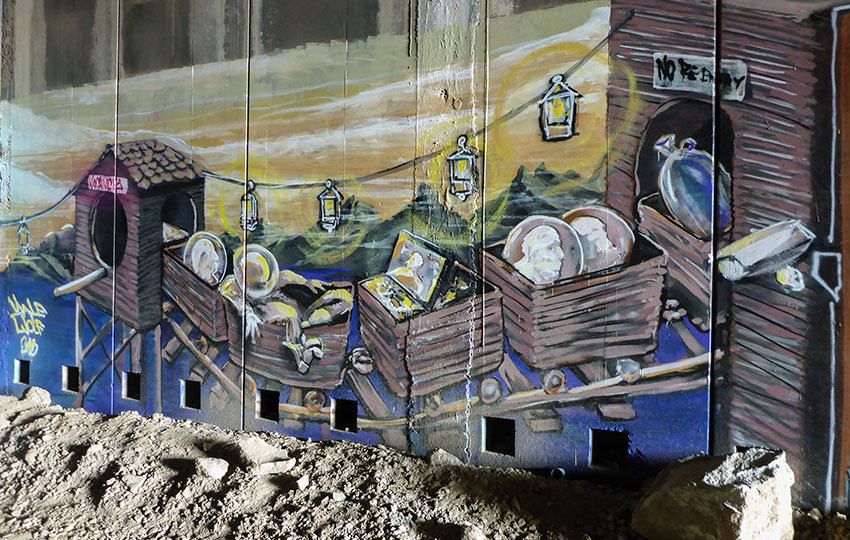

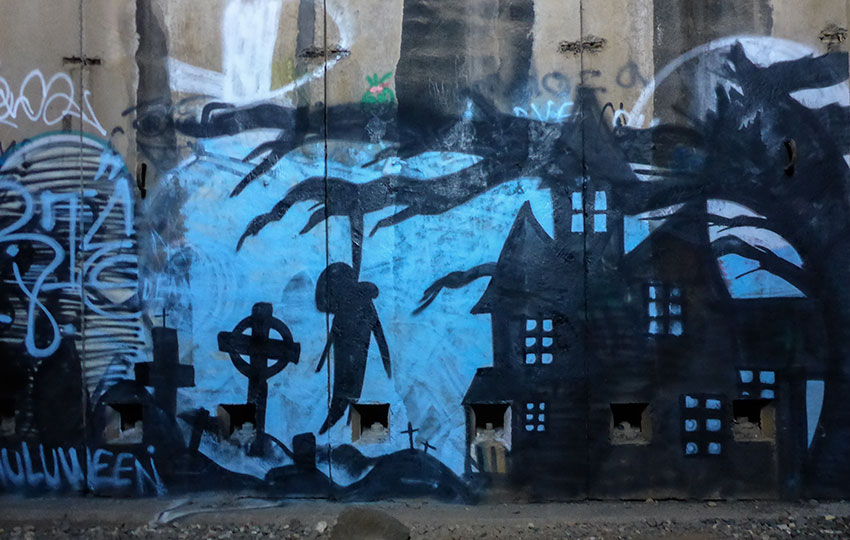
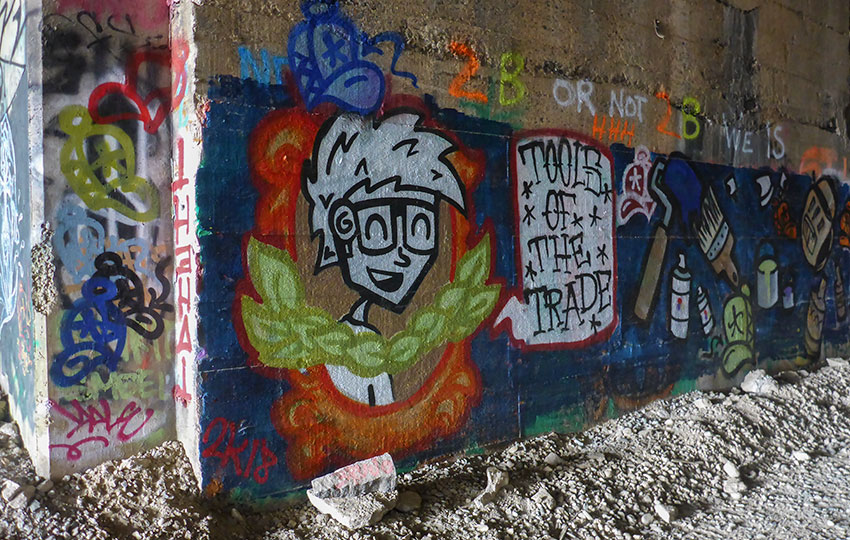
We enjoyed a great hike in the tunnels today. We were surprised to encounter a Jeep driving thru the tunnels. He was driving slowly and was considerate of hikers. Someone asked the driver if that was allowed and he confidently said it was legal. Is that true? Thanks!
Hey Ron,
Sorry about my delayed response! I spent most of last week preparing for guiding one of the Donner Summit Historical Society annual fundraiser hikes (https://donnerpartyhike.com/ ) that occurred this past weekend. I’ve been guiding the Roller Pass/Mount Judah loop hike for the past few years, and I usually end up spending the week prior dialing in my notes and going over the route, etc.
Anyway, I’m not 100% sure about it being “legal” to drive through the tunnels. I suspect the reason you don’t see more people driving through it is because it’s probably not permitted and vehicle access is not easy. Here’s the thing, though, over the years the Donner Summit Historical Society has reached out to the owners of the tunnels/property regarding getting permission to host one of its annual fundraiser hikes in the tunnels (“Railroad Summit Tunnel and More” at the aforementioned link). But they’ve never received any confirmation one way or the other. The theory is that the owners probably don’t want anything to do with anything that goes on in or around the tunnels so as to limit their liability if someone got injured or whatever. It just sounds like they’ve taken a laissez-faire approach to managing the property/tunnels.
So the tunnels are all private property whether we’re walking or driving through them, meaning that it’s all technically trespassing. However, since there are no signs or fences keeping people from visiting the Donner Summit tunnels, nobody is making an effort to enforce the private property element, and the fact that the tunnels have historical value, I think it’s just a no-man’s land/DMZ kind of scenario or an informal type of easement. So I can’t imagine that driving through them is “legal” but, again, with nobody enforcing any type of restrictions on access to the tunnels, it is what it is.
I’m sure that answer is about as clear as mud, but that’s all I can really come up with 🙂
I am glad to hear that the driver was considerate of all the hikers through the tunnel. But all I could think of is what would happen if, for whatever reason, that vehicle broke down or stuck in the tunnel. I guarantee they’d receive some sort of ticket/fine for trespassing at that point.
Thanks so much for reaching out! I appreciate the question. I’m having a follow-up gathering to the DSHS hikes this upcoming week, so I’ll try to get more information about the legality of travel through the tunnels and get back to you if I hear anything to the contrary of what I’ve already said 🙂
Hello Jared,
I have been enjoying the information on your webpage about the Donner Train Tunnels.
A question for you, if you park in the parking lot/ dirt parking area, how far is it one way to reach the area just above where Tunnel 41 exits on the east aide of Mt. Judah? and about how long does it take to walk down and back?
Look forward to hearing from you.
Thanks,
Jeff
Hey Jeff,
Holy cats! I’m so sorry about my delayed response. I’ve been going through a site migration thing with my web hosting for while now (meaning I’ve been on-hold during that time for making any changes and responding to comments). So I clearly missed your question.
Most of my hiking experience in this area is doing the Roller Pass/Mount Judah loop hike, which is roughly 7 miles roundtrip. So, if you were going to hike to where Tunnel 41 would be which is slightly shorter, I would estimate the roundtrip distance to be closer to 4-5 miles. So, you could probably expect to take approximately 2-3 hours to cover that distance.
I’m sure this info comes to you too late as it’s now the beginning of December. But I wanted to get back to you just the same.
Again, I really apologize for not responding sooner!
Are the tunnels in any way designated by the state or feds as historically important? Have they been classified as landmarks, for example?
Hey Peter,
Thanks so much for reading my article and reaching out 🙂
Based on speaking with some of the folks who are associated with the Donner Summit Historical Society, the railroad tunnels are still owned by the railroad (Union Pacific Railroad, I believe). So, they’re not an officially designated historical landmark as far as the Local, State, or Federal governments are concerned. Apparently, people associated with the Historical Society have, in the past, reached out to the railroad company to obtain permission to offer group tours in the tunnels (for the Historical Society’s annual fundraising event aka Donner Party Hikes, for example). But they’ve never received a reply one way or the other. So the belief is that the railroad company doesn’t really want anything to do with the tunnels. They don’t say that people can hike through them. And they don’t say that people can’t hike through them. There’s no real signage of any kind at the tunnels, so it sounds like they’re taking a laissez faire attitude toward them.
Anyway, that’s about all I know about the ownership/designation of the Truckee Tunnels. If I hear more definitive information I’ll be sure to post it.
Thanks again for the comment!
I enjoyed reading your article and viewing the photos you included. Reading Ghosts of Gold Mountain inspired me to search online for info regarding the Donner Tunnels and your piece was one of the first search results. Due to physical limitations, I will never be able to visit these places in person, so being able to see through your lenses was especially appreciated. Thank you!
Hey Nicole,
Thanks so much for the kind words 🙂
Ghosts of Gold Mountain is sitting on my bookshelf right now. One of the other commenters on this article recommended it, but I just haven’t made the commitment to dive in yet. But now that you’re reading it, too, I think I’ll move it to the top spot on my stack to read 🙂
Sorry to hear that you won’t ever be able to visit the tunnels. At some point, I’ll go and hike them again and I’ll be sure to grab some more photos for you!
Take care!
The train tressels are about the only thing that relates Tahoe (NF and LTB) and the SF Bay Area. San Jose provoked statewide chinese exclusion, becoming national and only previously in Truckee. Tahoe and SF Bay Area are technically separate as they should be. And so we have remnants of top notch work by great people… Yet it’s permitted for graffiti. Only in a section ? The railroad connects the east and west sides of the state and we aren’t urban or street people. Perfect centerpiece for a tourist hike!
Thanks for the feedback. I appreciate you reading the article 🙂
Very interesting hike recommendation–looking forward to taking this hike when we visit. Regarding the tunnel history, check out “Ghosts of Gold Mountain” by Gordon Chang, a recently-written book by a Stanford history professor as part of the golden spike 150th anniversary events. Extremely informative book that focuses on the experiences of the Chinese workers themselves, in the broader context of the building of the railroad and California settlement history in general. Construction of these tunnels, in specific, posed considerable dangers to the workers on the ground, between tunnel cave-ins, blasting accidents, and avalanches Not surprisingly, they were pushed very hard, including working all winter through a particularly snowy year, enduring bitter cold and tunneling through huge snow drifts to get to the construction site.
Hey Martin,
Thanks for the kind words, and I hope you do have a great hike. It’s definitely a different Tahoe experience. Hopefully when you hike the Donner tunnels, you’ll be there on a day with few people and the smoke from the Loyalton Fire near Reno will have dissipated. It’s pretty thick out there right now.
I appreciate the book recommendation, as well. I just ordered a copy 🙂
It’s always great when new work is created regarding historical events such as with the Chinese railroad workers. I find that a lot of older books about history tend to take some pretty drastic liberties with the presentation of information either because of lack of knowledge or bias. So, I’m looking forward to reading Ghosts of Gold Mountain.
In the same vein, there’s a relatively newer book about the Donner Party called “Desperate Passage” by Ethan Rarick. With so many books published about the Donner Party, you’d think there wasn’t much else to tell. But Rarick produced a book that brought a lot of new life to the story. Anyway, it’s worth a read if you’re into Donner history.
Thanks again for the comments. And, I hope you have a great time hiking the tunnels!